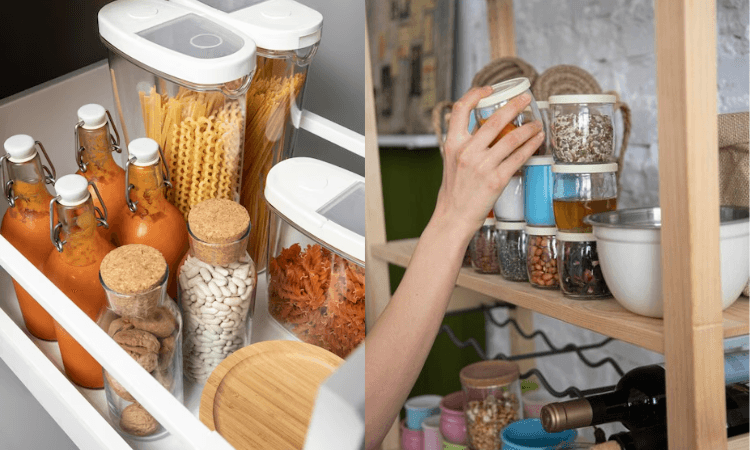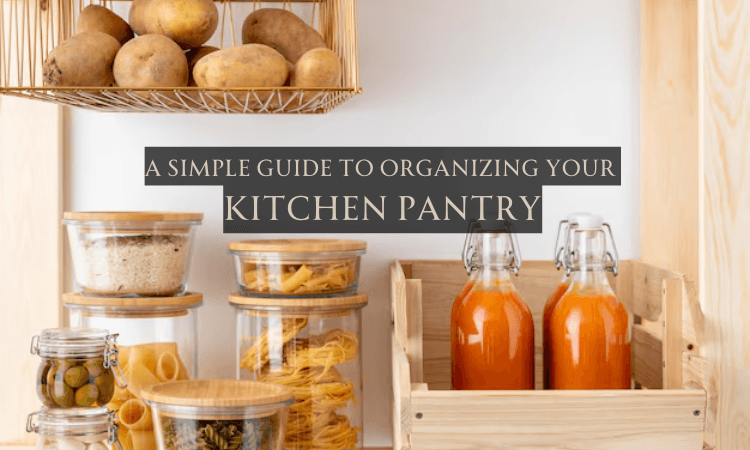A well-organized pantry is the heart of an efficient kitchen. It can save you time when preparing meals, help prevent food waste, and make it easier to find what you need. A cluttered pantry can make cooking stressful and lead to items getting lost, spoiled, or forgotten. If you’re overwhelmed by disorganized shelves and scattered ingredients, this guide will help you take control of your pantry. Whether you have a small cupboard or a large walk-in pantry, following these tips will make your pantry more organized, accessible, and functional.
Preparing Your Pantry for Organization
Before you dive into organizing, it’s crucial to prepare your pantry. This involves clearing out everything to take inventory of what you have and what you really need to keep.
Clear Out Everything
Start by removing everything from the pantry. Take everything out, even if you think you already know where things are. This allows you to assess the space and understand the quantity of items you have. As you take items out, sort them into categories: keep, toss, or donate.
- Toss expired items that can no longer be used.
- Donate non-perishable items you no longer need or want.
- Keep only the items you regularly use or will use in the near future.
Clearing the pantry gives you a fresh start. It also helps you avoid storing things that are old or unnecessary, making your pantry more efficient.
Clean the Space
Once your pantry is empty, take the time to clean the shelves. Wipe them down to remove crumbs, dust, and any spilled food. Check for any signs of pests, such as crumbs or nests, and address them before putting everything back. It’s also a great opportunity to rearrange or replace old shelving if necessary. You want a clean slate before you begin to organize, as it helps with maintaining order long-term.
Categorize and Group Your Pantry Items

After cleaning, it’s time to categorize your pantry items. Grouping items helps create a system that makes sense for both accessibility and organization.
Group Similar Items Together
Organizing by category saves you time and helps you find what you need quickly. Group your pantry items based on type, use, or size. Here are some common categories to consider:
- Canned goods (vegetables, beans, soups)
- Grains and pasta (rice, quinoa, spaghetti)
- Baking supplies (flour, sugar, baking powder)
- Snacks (chips, crackers, granola bars)
- Spices and condiments (salt, pepper, oils, vinegars)
By grouping similar items together, you’ll save time when you need to quickly find something, whether it’s dinner ingredients or a quick snack.
Label Your Categories
Once you’ve grouped your items, label the sections or containers. You can use clear bins or containers to make everything visible and easily accessible. A simple label like “Snacks,” “Canned Goods,” or “Baking Supplies” can help everyone in the household know where to find and return items.
- Use labels on shelves or bins to avoid confusion.
- Clear containers make it easier to see what’s inside.
- Label containers for more uniformity and ease of use.
Labeling also prevents miscommunication in the kitchen, especially if others are helping you with meal prep or grocery shopping.
Maximize Pantry Space and Accessibility
Maximizing space and ensuring easy access are key to an efficient pantry. When items are placed in a way that makes them easy to reach, you’ll find cooking and meal planning much simpler.
To make the most of your pantry space, adjust your shelves to fit both tall and short items. Keep frequently used items at eye level for easy access, while placing less-used items on higher or lower shelves. For smaller items, use bins, baskets, or stackable containers to avoid clutter. Clear containers help you quickly identify contents, and airtight containers keep dry goods fresh. By organizing both by size and frequency of use, you ensure that everything fits and is easy to reach.
Instead of cramming items into every available space, consider the layout of your pantry to avoid wasted space. Adjustable shelving can make a huge difference in accommodating various sizes of food storage containers and ensuring nothing gets lost behind others.
Organize by Expiration Dates and Frequency of Use
A critical part of pantry organization is maintaining a system that keeps track of expiration dates and prioritizes frequently used items. A simple but effective way to do this is by organizing your pantry based on expiration dates and how often you use certain items.
Arrange pantry items so that older items are placed at the front, following the “first in, first out” rule. This way, you’ll use up food before it expires. Place items with a shorter shelf life in more visible spots so they’re used first. Items that you use frequently, like spices, oils, or snacks, should be placed in easily accessible spots, such as lower shelves. Less-used items, like seasonal goods, can go higher or at the back. Regularly check expiration dates to prevent waste and keep your pantry organized.
Keeping essential items close at hand helps ensure you never run out of the basics, while rarer ingredients can be stored in less accessible spots.
Maintain Your Organized Pantry
Once your pantry is organized, it’s important to maintain it. Regular checks and small adjustments help ensure that your pantry stays neat and functional. Without maintenance, even the best-organized pantry can quickly fall back into chaos.
To keep your pantry organized, conduct a quick check each month. Remove expired items and reorganize if needed, especially if your food preferences or shopping habits change. Clean your pantry shelves periodically to keep things fresh. By making small adjustments and staying on top of organization, your pantry will stay neat, accessible, and efficient.
Remember, maintenance doesn’t have to be an overwhelming task. Small habits like wiping down shelves and moving items around as needed can prevent clutter from taking over your pantry.
Conclusion
A well-organized pantry can make meal preparation easier, save time, and help reduce waste. By clearing out clutter, grouping items logically, and using space efficiently, you can transform your pantry into a functional storage space. With regular checks and maintenance, your pantry will remain neat and accessible, making cooking and grocery shopping a breeze.
Follow these steps, and your kitchen will be better equipped to handle all your culinary needs with minimal stress.




